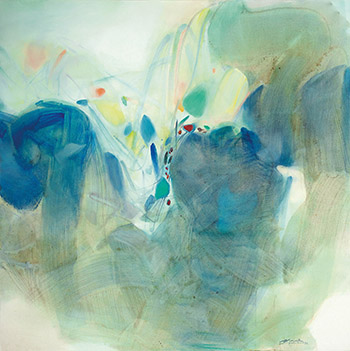ILLUSTRATED :
Chu Teh-chun, Works by Pierre Cabanne, Cercle d’Art, Paris, 1993,color illustrated, p. 190
Overseas Chinese Fine Arts Series II : Chu Teh-chun , Artist Publishing,Taipei, 1999, color illustrated, p. 253
Impressions Classics IX: Chu Teh-chun, Impressions Art Gallery,Taipei, 2005, color illustrated, no. 37, p. 66
This painting is to be sold with a certificate of authenticity issued byAtelier Chu Teh-chun
Catalogue Note:
Jeux Immat ériels
In 1955, Chu Teh-chun boarded a ship from Taiwan to Marseille. He then traveled by land to Paris, the city of art that once inspired his Hangzhou Arts School teachers like Lin Fengmian, Wu Dayu, and Cai Weilian. In the following year, after Chu Teh-chun viewed Nicolas De Staёl’s (1914- 1955) retrospective exhibition, the thoughts regarding abstract painting that had been brewing in his mind for some time seemed to have already matured, and it was from hence that the artist escaped all restrictions of the figurative. He entered the realm of abstract painting that was so fulfilling to his freedom-desiring soul, thereafter engendering an artistic universe that has since fascinated and intoxicated throes of admiring connoisseurs. If Western art’s pursuit of innovations that reflect the aura of a magnificent epoch and its search for the essences of color representation, lighting, and formal structure contributed greatly to Chu’s artistic achievement, then Chinese spiritual philosophy and its aesthetics of painting and calligraphy are what instilled an unparalleled sense of style and elegance into his works.
The scholarship of Chinese Classics and the artistic traditions of Chinese ink painting and calligraphy were deeply rooted in the formative education of Chu Teh-chun. Even after he settled in Paris, the artist did not forego the regular practice of calligraphy. This enabled him to demonstrate a mastery of strokes and contours in his oil paintings that is rarely attained by Western artists. Ever since Chu Teh-chun established his own exclusive creative direction of abstract painting in the latter 1950s, his paintings have often exhibited forceful, sweeping strokes of a calligraphic nature that embody awe and magnificence. Further on in his career, these calligraphic lines gradually softened and became more harmoniously integrated with the other elements of his canvas, just as he began accentuating the dramatic contrast between light and shadow. The composition and mood of Chinese landscapes were increasingly exemplified in the artist’s abstract paintings of vivid colors and invisible dynamic force. The charm of ink gradually became even more identifiable in the artist’s later works. At this time, he grew increasingly fond of diffusing diluted paints on his canvas, thereby endowing the originally thick, unadulterated colors with an inklike liquidity. This approach imbued in his paintings the fluid translucency of Chinese ink wash, yet still retained a level of visual substantiality and rich gradient colors that are unattainable with ink. A perfect example of this lightness and fluidity is Chu’s 1993 artwork titled “Jeux immatériels,” which fully conveys the artist’s intrinsic transcendence after having exhaustively interrogated the meanings of heaven and earth.
Chu Teh-chun loved the color blue. His blues are tranquil yet dynamic, filled with a power that deeply touches the souls of his viewers. In “Jeux immatériels”, he used large, profound, unrestrained blocks of color to attain a multi-layered expanse of blue in his configuration of a world of clarity and openness, well suited to meditative thought. This was achieved with brush strokes that were sometimes light and brisk, at other times deep and powerful. In the face of a canvas taller than himself, the artist remained unperturbed. He employed big, broad brush strokes to build a solid, substantial structure horizontally across the canvas, symbolizing a valley enclosed and guarded on either side by grand, towering peaks. Patches of brilliant color scattered at random upon the canvas signify the condensation and crystallization of heaven and earth into vibrant rocks that tinkle melodiously and dance with ethereal grace. The brush strokes of speed and momentum executed with the weightlessness of a maestro resemble fleeting fairy footsteps and an almost imperceptible dynamic energy. In the lower half of the canvas, brush strokes remain broad and sweeping, yet the colors gradually begin to fade as if diffusing into cloudy airiness, imbuing the entire work with a sense of graceful spirituality. As for the upper hemisphere of the canvas, the artist employed washes of color that infinitely extended toward the space beyond. The penetration of distant light on the horizon was as snowy as white velvet, bright but not overpowering, enchanting yet celestially pure.
French art critic Pierre Cabanne once described Chu Teh-chun’s accomplishments as “beyond the realms of abstraction, endowing the world with manifestations that connect the form and the formless into a reality, a visible existence” (Da Xiang Wu Xing: Chu Teh-chun Exhibition, Thin Chang Co., Ltd. p. 66). Blocks of green, orange, yellow, and ochre complement one another upon a foundation of gradient blue in “Jeux immatériels,” translucent, vibrant, vivacious, yet perfectly harmonious, just as if they were a part of God’s creation. It was thus that a celestial world of infinite sublimity appears before our eyes. From afar, it broadens the mind; up close, ever-changing, dynamic details and layers are forever enchanting. It is as if we are traversing upon the mighty, precipitous path hewn by the artist, discovering the profound mysteries of the universe, and witnessing the boundless dynamism of the course of nature. “beyond the realms of abstraction, endowing the world with manifestations that connect the form and the formless into a reality, a visible existence”
